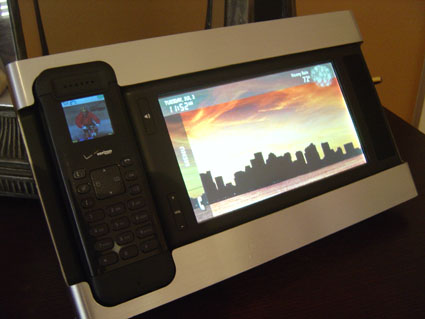
In the CE world, success is all about timing. Verizon debuted its Verizon One gadget years ago, but that was before the widget craze, before FiOS was a household word, and before streaming radio and digital photo frames raised the profile of non-computer, Internet-connected devices.
In its latest form, the Verizon One is now called the Verizon Hub, and Dave and I got a chance to see it during our recent visit to Verizon HQ. I love this thing. In brief, it’s a cordless-phone-plus-widget-station that lets you make calls, get news, weather and traffic, share photos and control your FiOS TV (Motorola) set-tops. There are plenty of things it doesn’t do, like let you surf the Web, but that’s what your computer is for. And with the Verizon Hub you won’t get distracted by all of the unread emails in your inbox when you just want to check traffic.
The Verizon Hub has a gorgeous display, a POTS connection (no VoIP), Wi-Fi and an Ethernet port. I’m drooling over the device, but ultimately I think its success will depend on cost. This is a whole new gadget category and it will take a reasonable price point to get the unwashed masses to try it out. That said, if there was ever a time when the Verizon Hub could be successful, it’s now. Lots of people use widgets and RSS feeds, and lots of people like to show off photo slideshows. This isn’t a complete paradigm shift anymore. — More pics after the jump.
 I was all set to blast Verizon for manipulating my parents into buying their DSL service when my dad gave me the surprising update: Verizon had admitted to making a mistake and fully refunded my parents’ money. Yup, you read that right. Full refund.
I was all set to blast Verizon for manipulating my parents into buying their DSL service when my dad gave me the surprising update: Verizon had admitted to making a mistake and fully refunded my parents’ money. Yup, you read that right. Full refund.